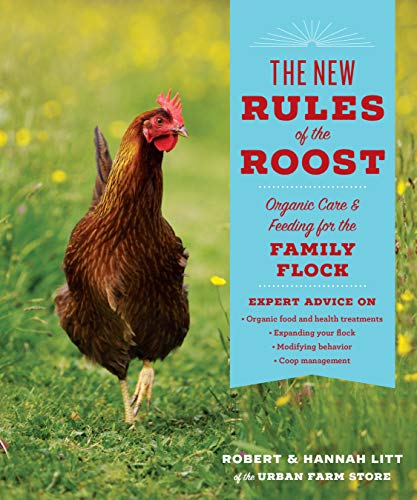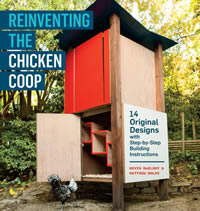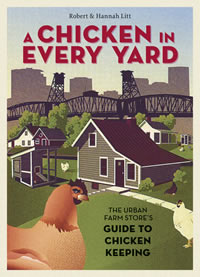 Robert and Hannah Litt of Portland wrote A Chicken in Every Yard, published in 2011. They regard their chickens as pets to pamper and keep safe – they only eat their eggs. This book will tell you how to do the same.
Robert and Hannah Litt of Portland wrote A Chicken in Every Yard, published in 2011. They regard their chickens as pets to pamper and keep safe – they only eat their eggs. This book will tell you how to do the same.
On a visit to the island of Kauai in Hawai’i, the Litt family discovered that chickens have naturalized and do quite well looking after themselves. This led to a new book, The New Rules of the Roost (2018) that incorporates some of this avian independence. Now the setting for their home flock is “more dynamic, so that our chickens can safely forage for food and scratch around, but when and where we want them to.”
How does all this work with the garden? Very well, if you consider the hens as part of the family – it just takes a lot of compromise and ingenuity.
Published in Garden Notes: Northwest Horticultural Society, Fall 2018
Kitchen Garden from Great Britain is the only magazine devoted to growing fruits and vegetables. The glossy monthly magazine includes growing tips from readers, articles on growing techniques and new cultivars, plus a monthly feature on small-scale chicken rearing. Subscribe for a mere $55.00 dollars a year at their website, or read it for free at the Miller Library.
 As a new graduate of the University of Washington’s Library and Information Science Master’s program, I began volunteering at the Miller Library in July 2011. I had some experience in academic libraries, and had worked as a student assistant in the UW’s Natural Sciences Library. After I began volunteering, I started reading and checking out several books on fruit and vegetable gardening. The books were great, and really helped me learn how to grow food.
As a new graduate of the University of Washington’s Library and Information Science Master’s program, I began volunteering at the Miller Library in July 2011. I had some experience in academic libraries, and had worked as a student assistant in the UW’s Natural Sciences Library. After I began volunteering, I started reading and checking out several books on fruit and vegetable gardening. The books were great, and really helped me learn how to grow food.
I decided to add chickens to my urban garden, making it a small urban farm. One of the best books that helped me prepare for my chickens was “Reinventing the Chicken Coop” by Kevin McElroy and Matthew Wolpe. The book contains 14 coop designs. It covers chicken coop essentials including space requirements, roosts, ventilation, and nesting boxes. This information was very helpful to me as I was learning what it would take to keep chickens in my yard. In the Coop-Building Basics chapter the authors explained, “One of our goals for this book was to keep things simple, using ordinary shop tools and building with similar materials and repeatable processes as much as possible” (p. 21). In the end, my husband and I built our coop using their design, SYM, which is “much more than a chicken coop; it’s a symbiotic urban farming system” (p. 106). This was exactly what we needed. The step by step instructions were easy to follow and it didn’t take too long to build this simple yet stable coop for our new flock. “Reinventing the Chicken Coop” is a great resource for building chicken houses with ease and low cost. Most pre-built coops cost twice as much as the materials used for building your own coop. I enjoyed the collection of contemporary designs and my chickens love their little home in my city backyard.
Now, I am a librarian at the Miller Library, with two years of experience in chicken husbandry and a growing knowledge of year-round vegetable and fruit gardening. I take pleasure in being knowledgeable on these subjects and plan to continue learning, expanding my understanding of urban farming.
Published in the November 2015 Leaflet Volume 2, Issue 11.
 Robert and Hannah Litt own the Urban Farm Store in Portland and wrote “A Chicken in Every Yard” from experience keeping their own chickens, and helping their chicken-keeping customers. While they don’t disapprove of raising chickens for food, theirs are clearly pets and the book encourages this attitude with chapters like “Parenting Your Peeps.” There is a lot of detail about different types and breeds, including recommendation lists such as “best for children.” All stages of raising and caring are covered in depth, but the garden is only briefly mentioned. If your focus is solely on chickens, this book is an excellent choice.
Robert and Hannah Litt own the Urban Farm Store in Portland and wrote “A Chicken in Every Yard” from experience keeping their own chickens, and helping their chicken-keeping customers. While they don’t disapprove of raising chickens for food, theirs are clearly pets and the book encourages this attitude with chapters like “Parenting Your Peeps.” There is a lot of detail about different types and breeds, including recommendation lists such as “best for children.” All stages of raising and caring are covered in depth, but the garden is only briefly mentioned. If your focus is solely on chickens, this book is an excellent choice.
Excerpted from the Winter 2013 Arboretum Bulletin.

First review:
Jessi Bloom is a strong advocate for chickens in almost any garden setting, and in “Free-Range Chicken Gardens,” she provides detailed information on compatible plantings–including those that provide food for chickens–and structures that meet the multiple needs of fowl and flora. There is a lot of well-organized information in these pages on all other related topics, too, making this of value to chicken keepers at any experience level. But you can also just enjoy the profiles of gardeners and their chickens (many are local) or the many superb photographs (by Kate Baldwin) of contented hens in their gardens, proving their value as a natural compliment.
Excerpted from the Winter 2013 Arboretum Bulletin.
Second review:
How does allowing chickens to range freely work with a garden? Very well – it just takes a lot of compromise and ingenuity. A book that deeply addresses these issues is Free-Range Chicken Gardens by Jessi Bloom of Seattle.
Here are specific guidelines for the design of a chicken compatible landscape. How to protect prize plants while still giving your flock the opportunity to roam and find a more natural diet. As a gardener, you are encouraged to try plant selections that will nourish your hens, or shelter them from predators or weather. The advantages can work both ways. Some plants will screen your chicken run, or even give off fragrance to mask odors.
Bloom recognizes this doesn’t work for everyone. “If your garden must be perfect…then you might not want chickens free ranging.”
Published in Garden Notes: Northwest Horticultural Society, Fall 2018
 Robert and Hannah Litt of Portland wrote A Chicken in Every Yard, published in 2011. They regard their chickens as pets to pamper and keep safe – they only eat their eggs. This book will tell you how to do the same.
Robert and Hannah Litt of Portland wrote A Chicken in Every Yard, published in 2011. They regard their chickens as pets to pamper and keep safe – they only eat their eggs. This book will tell you how to do the same. As a new graduate of the University of Washington’s Library and Information Science Master’s program, I began volunteering at the Miller Library in July 2011. I had some experience in academic libraries, and had worked as a student assistant in the UW’s Natural Sciences Library. After I began volunteering, I started reading and checking out several books on fruit and vegetable gardening. The books were great, and really helped me learn how to grow food.
As a new graduate of the University of Washington’s Library and Information Science Master’s program, I began volunteering at the Miller Library in July 2011. I had some experience in academic libraries, and had worked as a student assistant in the UW’s Natural Sciences Library. After I began volunteering, I started reading and checking out several books on fruit and vegetable gardening. The books were great, and really helped me learn how to grow food. Robert and Hannah Litt own the Urban Farm Store in Portland and wrote
Robert and Hannah Litt own the Urban Farm Store in Portland and wrote 